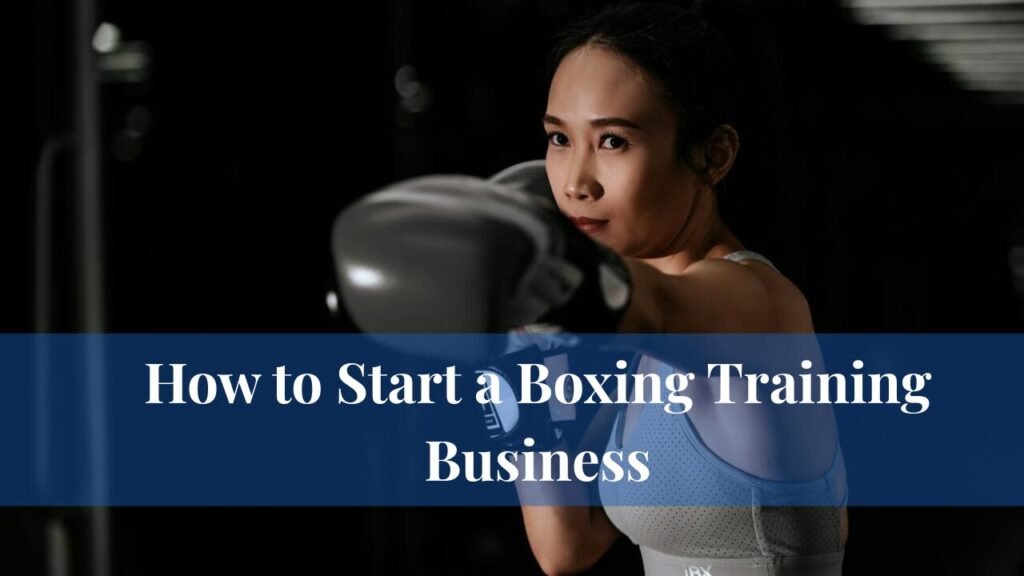Starting a boxing training business can be a rewarding career path that not only benefits your personal goals but also empowers others through fitness and discipline. Whether you’re aiming to open a boxing gym, provide one-on-one training, or launch an online coaching platform, this guide will walk you through everything you need to know.
Why Start a Boxing Training Business?
Boxing is not just a combat sport; it’s a complete fitness regimen that promotes strength, agility, endurance, and mental focus. In today’s health-conscious world, people are increasingly drawn to activities that combine physical conditioning with stress relief. Boxing provides both, making it one of the fastest-growing fitness trends. Beyond being a sport of competition, boxing has entered mainstream fitness programs because it helps participants build lean muscle, improve coordination, and enhance cardiovascular health.
With rising interest in combat sports and fitness boxing classes, starting a boxing training business offers the chance to position yourself in a high-demand industry. Fitness boxing appeals to athletes, casual exercisers, and even those seeking self-defense. The global fitness industry continues to grow, and boxing’s unique blend of strength training, endurance, and mental discipline gives it a strong edge. Unlike traditional gyms, boxing gyms foster community, create loyalty, and allow trainers to develop multiple revenue streams. From personal training packages to branded merchandise and community-driven events, entrepreneurs in this space are tapping into a dynamic and sustainable market.
Step-by-Step Guide to Launch Your Boxing Training Business
1. Define Your Niche and Business Model
Before jumping into logistics, it’s important to define your niche. Every boxing business thrives on specialization. Some entrepreneurs open traditional boxing gyms focused on competitive and amateur training, while others build fitness boxing studios designed for cardio and weight loss. Parents often seek youth programs where kids and teens can develop discipline, confidence, and fitness through structured boxing lessons. With the rise of digital learning, online coaching platforms are also expanding rapidly, giving trainers the ability to reach clients globally through personalized classes, video libraries, and subscription-based programs.
Your chosen business model will determine how you structure memberships, whether you prefer pay-per-session plans, private training, or hybrid models that combine in-person and online programs. Some trainers diversify by offering corporate wellness packages, on-demand video courses, or community-based pop-up workshops. The clearer your niche, the easier it will be to market your services and attract the right clients.
2. Create a Business Plan
No business succeeds without a roadmap, and your boxing training business is no exception. A detailed business plan not only guides your strategy but also shows potential investors or partners that you are serious and prepared. Clearly outline your mission, your target audience, and the unique services you plan to offer. Include your marketing strategies, competitor research, and financial projections.
A well-rounded business plan also includes a SWOT analysis that highlights your strengths, weaknesses, opportunities, and threats. For instance, your strength might be your experience as a competitive boxer, while your challenge could be limited startup funds. By addressing these early, you can minimize risks and maximize potential growth. Projecting revenue for the first three years helps you stay realistic and track progress as your business expands.
3. Choose the Right Location
Your location can make or break your boxing training business. A gym in a busy urban neighborhood with high foot traffic and easy parking is more likely to attract steady clients than a hidden facility with poor visibility. Demographics also matter young professionals, students, and fitness enthusiasts often live in specific neighborhoods where boxing gyms thrive. The ideal gym space is between 1,500 and 2,000 square feet, allowing room for equipment, classes, and member comfort.
If you are working with a smaller budget, shared fitness facilities or community centers can serve as a cost-effective starting point. Many successful gyms began in modest locations but grew steadily by reinvesting profits and building strong reputations.
4. Register Your Business
Turning your passion into a legitimate business requires proper registration. Choose a business name that reflects your vision, register your LLC or other legal structure, and apply for the necessary licenses. Liability insurance is critical in the fitness industry to protect yourself and your clients. An Employer Identification Number (EIN) is also necessary if you plan to hire staff. Regulations vary by state or country, so researching local laws ensures compliance and avoids penalties.
5. Invest in Equipment
The right equipment defines your training environment. At a minimum, most gyms require heavy bags, speed bags, gloves, mitts, and protective wraps. A professional boxing ring is optional but adds credibility, especially if you plan to train amateur fighters. To diversify your services, add strength and conditioning tools like dumbbells, kettlebells, resistance bands, and jump ropes. Installing mirrors helps clients monitor form, while padded flooring enhances safety. Ventilation, music systems, and proper lighting create a motivating atmosphere.
Starting lean is often the smartest approach. By negotiating with suppliers or leasing equipment, you can save money and upgrade as your membership grows. Many successful gyms started small and expanded equipment options gradually.
6. Hire Certified Trainers
The expertise of your trainers is central to your brand’s reputation. Clients feel more confident when guided by certified professionals. Look for trainers with certifications from organizations like USA Boxing or ACE, and ensure they also hold CPR and first aid credentials. Trainers with competitive experience bring valuable insights into technique and discipline.
Diversity in your team strengthens your brand. Having both male and female trainers, multilingual staff, and specialists in different fitness levels allows you to serve a broader audience. Continual education ensures trainers stay up to date with new fitness methods, ensuring your business remains relevant.
7. Build a Strong Brand
Branding is about more than just a logo; it’s the full experience your clients receive. A professional website, consistent social media presence, and branded merchandise all contribute to credibility. Sharing client success stories, running community events, and creating a memorable tagline enhances brand loyalty. A strong brand is built on authenticity, so highlight your journey, values, and commitment to client success.
8. Marketing and Promotion
Even the best gym will fail without effective marketing. Search engine optimization ensures your website ranks for local keywords such as “boxing classes near me.” Social media campaigns on Instagram and Facebook can showcase your classes, while YouTube tutorials establish your authority. Email marketing keeps clients updated on promotions, and referral programs incentivize loyal members to spread the word.
Collaborations with local influencers, free community workouts, and offering discounts for first responders or students help broaden your reach. Video content is particularly effective in fitness marketing, giving potential clients a real glimpse into your training style.
9. Set Up Your Pricing
Your pricing must balance affordability with value. Competitive rates encourage trial memberships, while premium packages cater to clients seeking personalized training. Monthly memberships, drop-in classes, and family discounts provide flexibility. Offering bundles or unlimited passes helps retain clients for the long term. Consider integrating modern payment systems that support recurring billing and online transactions for convenience.
10. Deliver Top-Notch Customer Service
Customer service is the foundation of client retention. A clean and welcoming environment makes clients feel comfortable, while friendly staff create a positive first impression. Providing easy online scheduling, quick responses to questions, and personalized training plans ensures clients feel valued. Recognizing milestones through member appreciation programs, such as “Member of the Month,” boosts morale and strengthens community bonds.
11. Track Progress and Scale
Tracking client progress and business growth is essential. Gym management software allows you to monitor attendance, manage memberships, process payments, and evaluate performance. Data-driven decisions help identify strengths and areas for improvement.
Scaling your business can include opening new locations, launching mobile training apps, or even creating certification programs for future trainers. Online expansion through digital courses or subscription models ensures long-term revenue beyond physical spaces.
Real-World Case Studies
Rise Boxing Club in Los Angeles began as a small garage setup and expanded into a 4,000-square-foot studio in just two years by targeting tech professionals with early morning classes. FitFight UK grew through Instagram and TikTok, sharing daily fitness tips and engaging challenges that attracted over 50,000 followers. Their digital-first approach helped them open three successful branches across the United Kingdom.
FAQs
What qualifications do I need to start a boxing training business?
You don’t necessarily need formal education, but certifications from bodies like USA Boxing, ACE, or NASM are highly recommended.
How much does it cost to open a boxing gym?
Startup costs range from $15,000–$50,000 depending on size, equipment, and location. This includes lease deposits, equipment, licensing, and initial marketing.
Can I start a boxing business from home?
Yes, especially for online coaching or private sessions if you have a safe, well-equipped space. Many trainers use garages or dedicate a spare room with basic equipment.
What licenses are required?
You’ll need a local business license, liability insurance, and possibly a health permit if offering wellness services. Always check with local business regulatory agencies.
How can I stand out from competitors?
Offer unique value like youth programs, female-only classes, community events, or nutrition coaching. Gamify classes with progress boards, badges, and challenges.
Conclusion
Starting a boxing training business is a bold yet rewarding journey. With careful planning, expert trainers, and a strong vision, you can create a fitness hub that not only builds strength but also transforms lives. Aligning your services with community needs and maintaining high standards of professionalism will ensure long-term growth.
Whether your dream is to create a neighborhood fitness hub or a globally recognized brand, the journey begins with passion, persistence, and a clear plan. Each punch thrown in the gym represents not only physical strength but also the commitment to building a healthier, stronger community. To continue exploring insights, tips, and resources about boxing, visit Boxing Essential and stay inspired.




